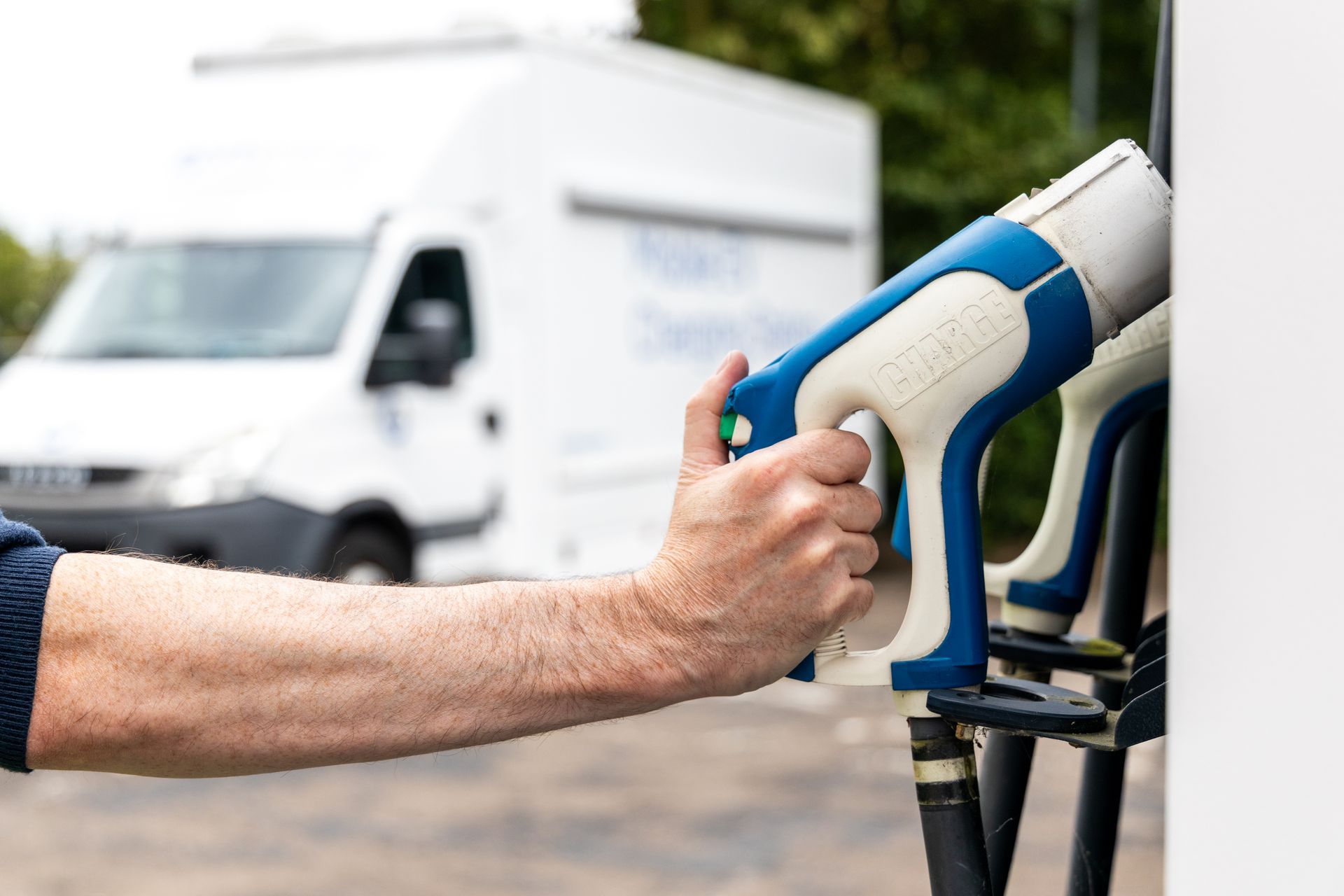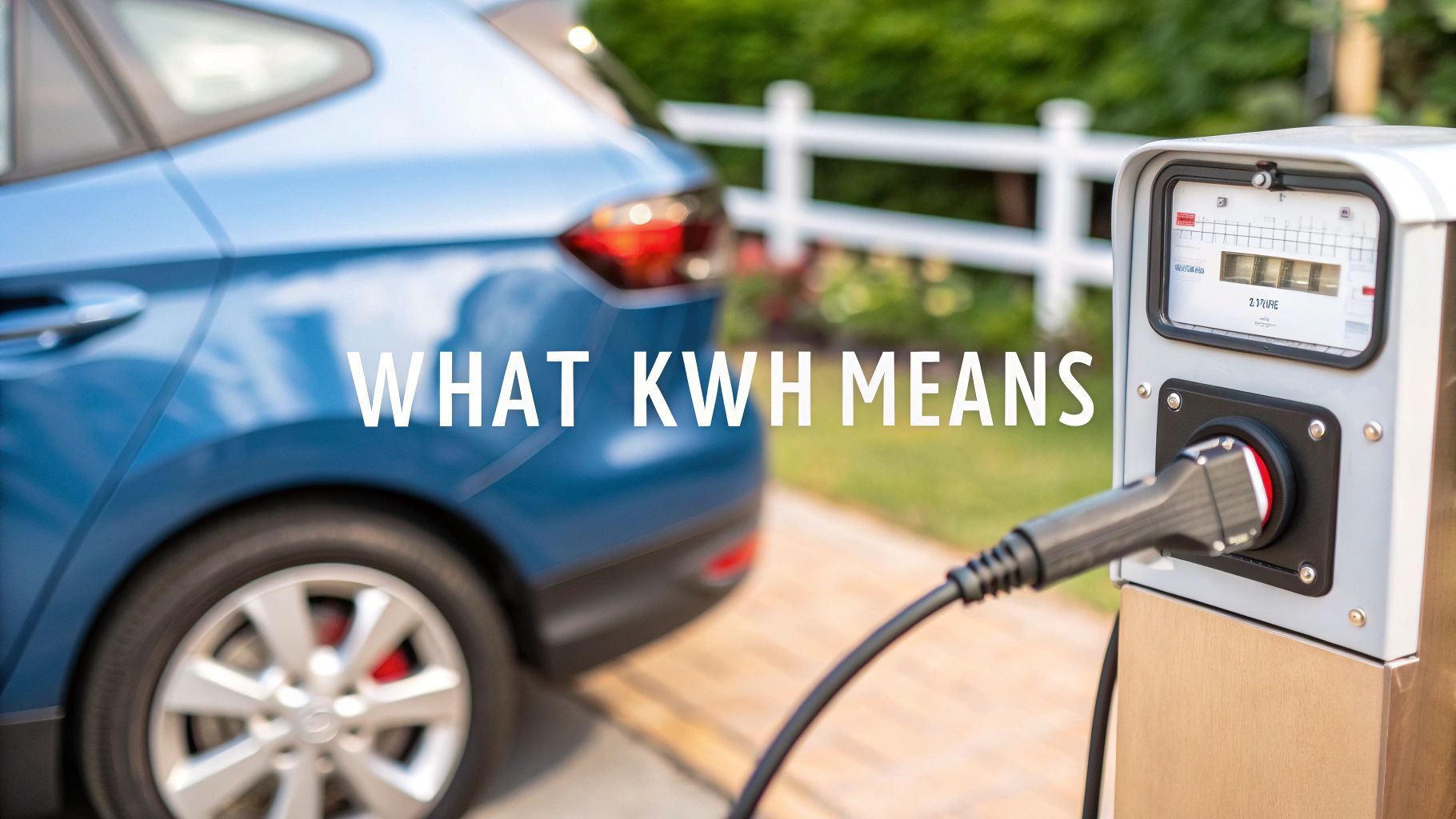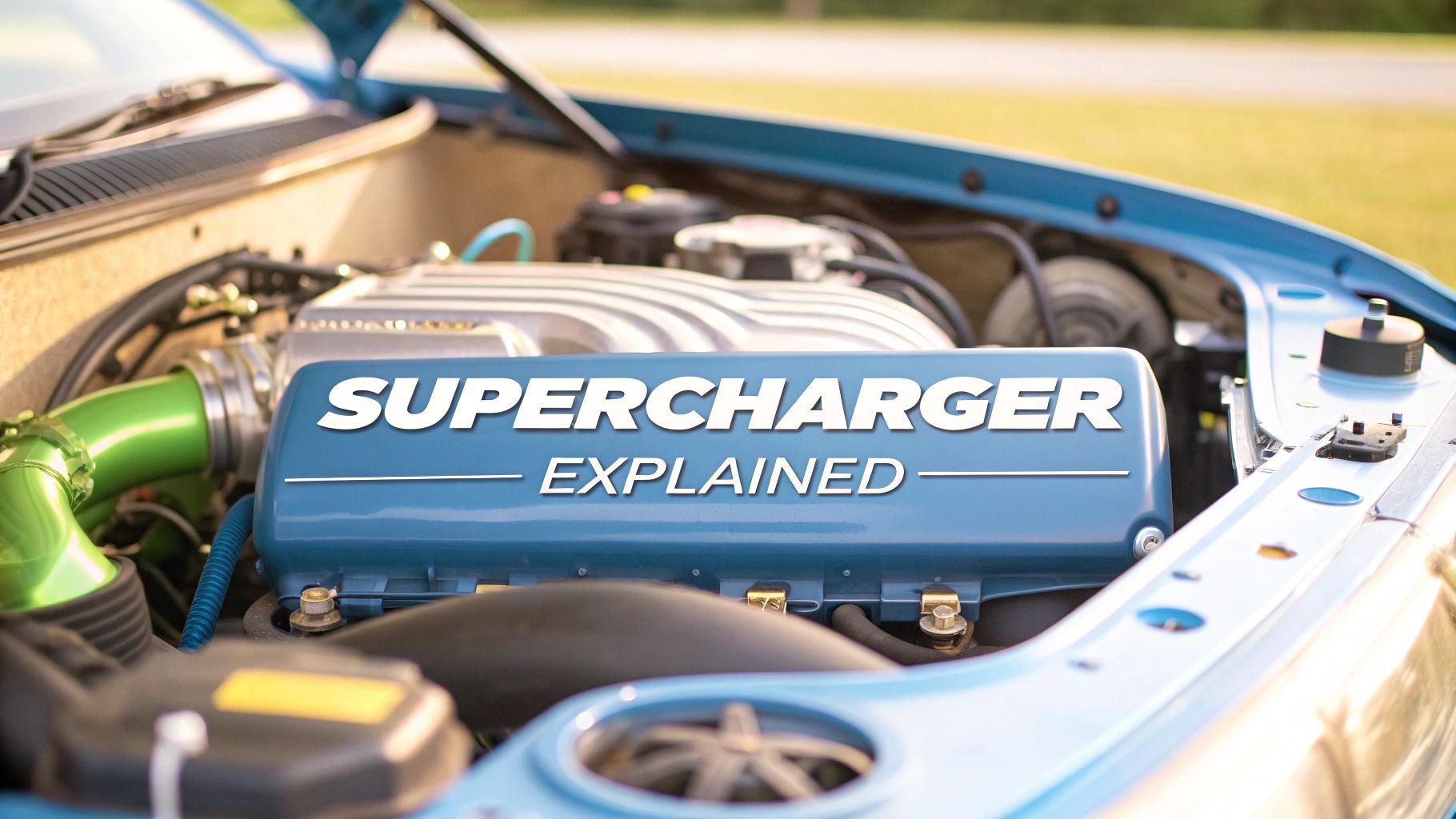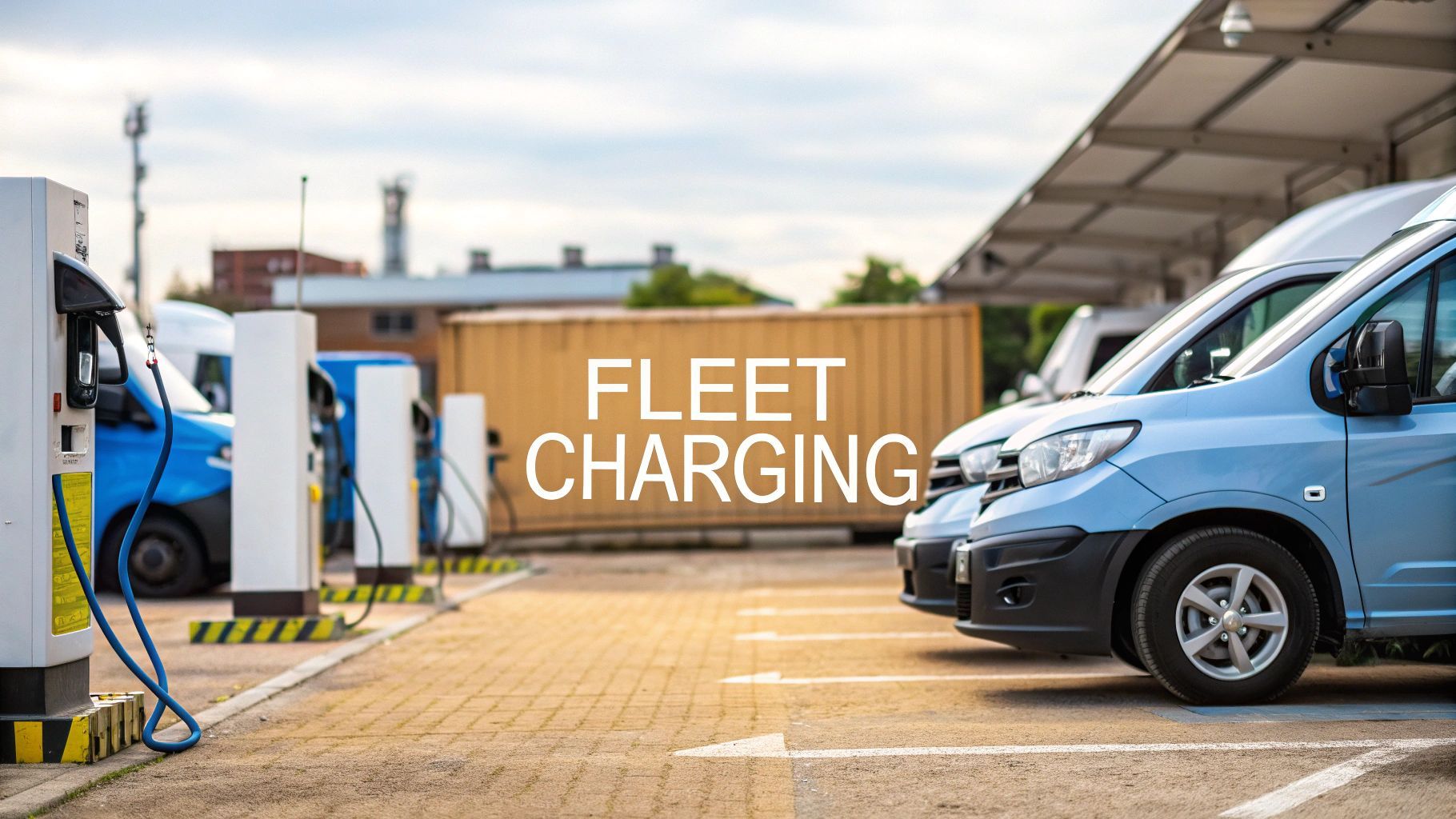UK Electric Car Charging Networks Explained
Think of electric car charging networks as the new petrol stations—the essential backbone powering the UK’s shift to electric motoring. They’re the sprawling system of public and private charge points keeping EVs on the road. As we collectively move away from fossil fuels, getting to grips with this infrastructure is no longer optional; it’s key.
Decoding the UK Charging Landscape
Dipping your toes into the world of electric vehicles can feel like learning a new language. At its core, the UK’s charging network is the ecosystem making this entire transition possible but it comes with its own quirks and innovations. For drivers, this network is the single most important tool for conquering ‘range anxiety’—that nagging fear of your battery dying miles from a charger.
The good news? This infrastructure is growing at an incredible pace. You do not have to look far to see the progress, with recent data showing a huge jump in the number of public chargers available.
As of October 2025, the UK's public charging network has expanded to a total of 86,021 charge points. That’s a 23% increase in just one year, meaning over 15,000 new chargers were installed across Britain. You can dig deeper into the numbers over at Future Transport News.
The Challenge of Coverage
Despite the impressive numbers, it is not all smooth sailing. Big challenges remain. Many regions, especially rural ones, are still starved of charge points, creating what many drivers call 'charging deserts'. This patchy coverage makes long-distance journeys a headache and puts off potential EV buyers who just do not have reliable charging access nearby. It is a critical hurdle the industry has to clear to make electric motoring a real choice for everyone, everywhere.
This is exactly why new thinking is so vital. While the fixed network slowly expands, a far more flexible solution is emerging to plug the gaps and get power precisely where it’s needed most.
The Rise of Mobile Charging
Imagine this: instead of you driving to a charger, the charger comes directly to you. Whether you are stuck on a remote country lane or parked in a flat without your own charging spot, the power arrives right where you are. This is the simple but powerful promise of mobile charging.
It’s a game-changer for drivers and opens up a whole new world for entrepreneurs:
- Ultimate Convenience: Get a top-up at home, at the office or on the roadside. No more hunting for an available fixed charger.
- Fills Infrastructure Gaps: It brings essential coverage to rural spots and city centres where installing permanent chargers is a nightmare.
- Creates Business Opportunities: Operators can build a profitable business providing this on-demand service, tapping into a booming market without the eye-watering costs of fixed installations.
Choosing the Right Charger for Your Journey
Not all chargers are created equal across the UK's electric car charging networks. Picking the right one for your needs can be the difference between a quick top-up and a frustratingly long wait. Getting your head around the basics is the key to making every charging stop efficient and stress-free.
The biggest distinction to grasp is between Alternating Current (AC) and Direct Current (DC) charging. Think of it like this: your EV's battery can only store DC power. When you plug into an AC charger, your car’s onboard converter has to do the extra work of changing the electricity from AC to DC first.
This conversion process is what limits the speed. AC charging is like a steady tap filling a bucket overnight—it’s perfect when you have plenty of time, like at home or work but it’s not much help when you are in a hurry.
The Need for Speed: AC Versus DC Power
DC charging, on the other hand, is like a fire hose. These beefy units bypass your car's internal converter and pump DC power straight into the battery. This allows for much, much faster charging speeds, making DC chargers the go-to for rapid top-ups on long journeys or at motorway service stations.
This is why you’ll see different charger "levels" or speeds advertised. They range from slow lamppost chargers that might add a few miles of range per hour, all the way up to ultra-rapid DC units that can get most modern EVs back to an 80% charge in under 30 minutes .
This infographic gives you a simple decision-making flow for a typical EV driver's needs.

The visual highlights the immediate choice every driver faces: when your battery is low, the priority is always finding the nearest suitable charging point.
Matching Plugs and Ports
Beyond speed, you also need the right physical connection. Fortunately, the UK market has largely standardised, which really simplifies things for drivers navigating the various electric car charging networks. Different plugs are designed for different power types and speeds.
- Type 2 Connector: This is the standard for AC charging across the UK and Europe. You’ll use this plug for home wallboxes, workplace chargers and most public AC posts.
- CCS (Combined Charging System): This is the rapid charging champion. It cleverly combines a Type 2 connector with two extra DC pins below it, allowing a single port on your car to accept both slow AC and ultra-rapid DC power.
- CHAdeMO: An older DC standard, primarily used by the Nissan Leaf and a handful of other models. While you’ll still find them, CCS has become the dominant standard for new vehicles.
To help you visualise the differences, here's a quick breakdown of what you'll encounter on UK roads.
Comparison of UK EV Charger Types
| Charger Type | Power Output (kW) | Typical Charging Time (to 80%) | Best Use Case |
|---|---|---|---|
| Slow | 3-6 kW | 8-12 hours | Overnight home charging, long-stay car parks |
| Fast | 7-22 kW | 3-5 hours | Workplace charging, shopping centres, public posts |
| Rapid | 50 kW+ | 20-60 minutes | Motorway services, dedicated public charging hubs |
| Ultra-Rapid | 150-350 kW | 15-30 minutes | Quick top-ups on long journeys for compatible cars |
This table makes it clear that the right charger really depends on how much time you have and where you are.
Choosing the right charger isn't just about speed; it's about compatibility. Knowing your car’s plug type ensures you can connect to the right electric car charging networks, turning potential confusion into confident, hassle-free journeys.
Getting familiar with the different connector types is a vital step for any new EV owner. To make things even clearer, check out our detailed breakdown of electric car charging plugs in our ultimate guide . It'll help you identify exactly what your car needs and which chargers to look for on the road.
Navigating the Reality of Public EV Charging
Knowing the difference between charger types is one thing but using the UK’s public electric car charging networks in the real world is a whole other experience. On paper, the infrastructure is growing at an impressive clip. In practice, however, drivers often face a frustrating mix of seamless charges and unexpected setbacks.
Big names like Gridserve, Pod Point and IONITY have become familiar sights at motorway services and retail parks. They’re driving the expansion, especially with the development of large, multi-charger hubs that make topping up on a long journey far simpler than it used to be.
These hubs are quickly becoming the new standard for on-the-go charging. By grouping multiple high-power units in one place, they cut down on queuing and ensure more drivers can plug in at the same time.
The Rise of Charging Hubs
The growth of these larger sites is a clear sign that the network is maturing. Public charging hubs—locations with six or more rapid or ultra-rapid chargers—are now central to the UK’s EV strategy. By late 2025, there were 663 such hubs across the country, with an incredible 212 added in the last year alone. These hubs often feature chargers rated at 300kW or higher, dramatically cutting down wait times for compatible vehicles.
This rapid expansion provides a much-needed confidence boost, especially for anyone undertaking longer trips who needs to rely on dependable electric car charging networks.
But despite this progress, the on-the-ground reality can still feel like a lottery. The ideal scenario—arriving at a vacant, fully functional rapid charger—is not always guaranteed. Plenty of drivers have stories of pulling up to a charge point only to find it broken or occupied.
Common Driver Frustrations
The day-to-day experience of using public infrastructure often means navigating a few common hurdles. These issues shine a light on the gaps that still exist in the UK’s charging ecosystem.
- The Postcode Lottery: Charger availability varies hugely by region. While cities and major motorways are increasingly well-served, many rural and remote areas remain ‘charging deserts’, making EV ownership impractical for some.
- Reliability Issues: One of the biggest complaints is simply whether the charger will work. Arriving at a station with a low battery only to find the unit is out of service is a major source of stress and can derail a journey completely.
- App Overload: So many networks require their own app and payment method. This fragmentation means drivers often need a whole folder of apps on their phone just to access the public network, complicating what should be a simple process.
These challenges create an inconsistent experience that can undermine the convenience of driving an electric vehicle, and they highlight a clear need for more dependable and flexible solutions.
The core problem isn't just the number of chargers, but their accessibility and reliability. When a driver cannot depend on the public network to work every single time, it creates uncertainty and damages confidence in the entire EV transition.
This inconsistency is precisely where alternative solutions become essential. If the fixed infrastructure fails or simply is not there, a backup plan is needed. For a deeper analysis of the key players and their coverage, you can read our guide to understanding the UK's public EV charging point networks in 2025.
The current system, with its mix of excellent hubs and unreliable single chargers, paints a complex picture. It underscores why a one-size-fits-all approach to charging just does not work. For the EV experience to become truly seamless for everyone, everywhere, a more adaptable solution is needed—one that can fill the gaps left by fixed infrastructure. Mobile charging services provide exactly this flexibility, delivering power wherever and whenever it is needed most.
How Mobile Charging Solves Everyday EV Problems
Fixed electric car charging networks are the bedrock of the EV transition but what happens when that bedrock cracks? What if the charger you need is broken, occupied or simply does not exist where your journey ends? The answer is not just to build more fixed points; it is to rethink how we deliver power.
What if, instead of you searching for a charger, the charger came directly to you?
This is the straightforward yet powerful idea behind mobile EV charging. It flips the entire model on its head, transforming charging from a destination you must reach into a service that meets you wherever you are. This simple shift addresses the most common and frustrating weaknesses of static infrastructure, offering a lifeline to drivers and a new layer of convenience to the EV experience.

A Solution for Every Scenario
Mobile charging shines brightest in the very situations where fixed networks fall short. Think of the driver stranded on a quiet rural road, miles from the nearest town. A quick call can dispatch a mobile unit to deliver the crucial top-up needed to get them safely on their way, turning a potential crisis into a minor inconvenience. This on-demand rescue service effectively eliminates range anxiety for good.
Consider the growing number of people living in flats or terraced houses without a dedicated driveway. For them, installing a home charger is impossible, making them entirely dependent on a public network that might be unreliable or inconveniently located. Mobile 'charging-as-a-service', provided by companies like ZAPME, allows them to book a charge at the kerbside, just as if they had their own private charge point.
The Financial Upside for Mobile Operators
The advantages of mobile charging extend far beyond driver convenience; they create a compelling business model for operators. Running a mobile charging service offers an accessible and profitable entry into the booming green economy, with a much lower barrier to entry compared to installing fixed infrastructure.
The revenue streams are diverse and direct, allowing an operator to build a strong financial foundation.
- Per-kWh Energy Sales: The most direct income source is selling electricity. Operators buy energy at a standard rate and sell it at a premium, with the margin representing their profit.
- Call-Out Fees: For emergency roadside assistance or scheduled appointments, a fixed call-out fee can be charged. This fee covers travel time and the convenience of the on-demand service.
- Subscription Models: Operators can offer monthly or annual subscriptions to local residents or businesses, providing a set number of charges for a recurring fee and guaranteeing predictable income.
- Fleet Service Contracts: Businesses with electric vans or company cars are a prime market. Securing a contract to provide overnight or on-site charging for a commercial fleet creates a stable, high-volume revenue stream.
This model allows an entrepreneur to generate income from day one, turning the gaps in the UK's charging coverage into a direct business opportunity.
Mobile charging is not just a backup plan; it is a premium service that meets the demands of a modern lifestyle. By delivering power on-demand, it makes EV ownership practical for millions of people who are currently excluded by the limitations of fixed infrastructure.
Why Mobile is a Smarter Investment
Starting a mobile charging business with a ZAPME unit sidesteps the biggest hurdles associated with fixed charge points. There are no colossal upfront costs for groundwork, no complex planning permissions to navigate and no expensive, time-consuming grid connections to arrange. An operator's primary investment is the mobile unit and vehicle, making the entire venture leaner and more agile.
This flexibility is a key financial advantage. A fixed charger is a sunk cost tied to one location; if demand in that area drops, the asset cannot be moved. A mobile unit, however, can go wherever the demand is highest. An operator can service a music festival one weekend, a business park during the week and a residential neighbourhood in the evenings, constantly adapting to maximise their earning potential.
This ability to dynamically respond to market needs means a mobile charging operator can start making money immediately. Imagine an operator with a single mobile unit. By completing just a handful of service calls per day—a mix of emergency rescues, scheduled residential top-ups and a small fleet contract—they can build a profitable enterprise.
A typical roadside assistance call-out, including a service fee and the energy sold, could generate £60-£100 per job . Servicing a small local fleet of four vans overnight could bring in a further £120-£160 consistently.
This scalability is where the model truly excels. An operator can start with one vehicle and, as their customer base grows, expand to a fleet of mobile units serving an entire region. This lean, flexible approach is perfectly suited to the evolving needs of the UK’s electric car charging networks, making it a smart and lucrative business for the modern entrepreneur.
The Business Case for Mobile Charging Operators
Beyond the obvious convenience for drivers, mobile charging opens up a powerful business opportunity. It’s a surprisingly accessible and potentially lucrative entry point into the green economy, especially when you compare it to the eye-watering costs of installing fixed electric car charging networks. The whole model is built on flexibility and low overheads, turning those frustrating charging gaps into a genuinely profitable enterprise.
This lean approach means an entrepreneur can start small and scale up intelligently. Unlike a static charge point, which is a huge sunk cost chained to a single location, a mobile unit is a dynamic asset. It can be sent wherever demand is highest—from residential streets with no off-street parking to sprawling business parks or even temporary events like festivals and markets.

This adaptability is the core of its financial strength. An operator is not just sitting around waiting for customers to find them; they are actively going where the business is.
Unlocking Multiple Revenue Streams
A mobile charging business is not just a one-trick pony. Operators can build a robust financial model by blending several different revenue streams, which helps to create a stable and predictable cash flow.
- Per-kWh Energy Sales: The most straightforward income is from the electricity itself. An operator buys energy at a wholesale or domestic rate and sells it to the customer at a premium. That margin is direct profit on every single charge delivered.
- Call-Out and Service Fees: For both emergency roadside assistance and pre-booked appointments, a standard call-out fee can be applied. This covers the operator's time, travel costs and the sheer convenience of the on-demand service.
- Scheduled Charging Contracts: This is where you build consistent, reliable revenue. An operator can lock in contracts with local businesses to charge their electric fleet vehicles overnight or with property managers to service residents in a block of flats.
- Subscription Services: Offering a monthly subscription for a set number of charges provides predictable recurring income and helps build real customer loyalty within a specific local area.
By mixing these income sources, an operator can create a business that is both resilient and highly profitable. An emergency call-out might generate £70-£120 for a single job, while a contract to charge a small fleet of four vans could consistently bring in over £150 per session.
Significant Cost Advantages Over Fixed Infrastructure
The most compelling financial argument for mobile charging is the dramatic reduction in start-up costs and complexity. Installing a fixed rapid charger is a monumental task, involving huge capital investment and endless bureaucratic hurdles.
The real power of the mobile charging model lies in what you do not have to pay for. There are no expensive grid connection studies, no disruptive and costly groundwork and no lengthy battles for planning permission. This lean start-up model puts profitability within reach much, much faster.
A mobile operator's main costs are the vehicle and the charging unit itself. This makes the entire venture far more agile and less risky. If one neighbourhood proves unprofitable, the operator can simply shift focus to another part of the city without losing their initial investment. This kind of flexibility is impossible with a fixed charge point, which is permanently tied to its location, for better or for worse. To explore this model in greater detail, you can read our deep dive into the economics of mobile EV charging.
A Scalable Path to Growth
The mobile charging model is perfectly designed for scalable growth. An entrepreneur can start with a single vehicle and charging unit, serving a specific local community. They can build a customer base, prove the concept and generate profit right from the outset.
As demand grows and revenue increases, the profits can be reinvested into a second vehicle, then a third and so on. This methodical expansion allows an operator to build a fleet that can service an entire town or region, creating a substantial business from a modest starting point. It is a practical, low-risk way to build a significant presence within the UK’s evolving electric car charging networks.
The Future of UK Electric Car Charging
Looking ahead, the UK's charging network is gearing up for a major evolution. It’s moving beyond a simple collection of fixed charge points to become a smarter, hybrid ecosystem. The journey so far has been impressive but the future is not about choosing between fixed or mobile charging—it’s about weaving them together intelligently.
This blended approach is the key to building a network that’s genuinely resilient and puts drivers first. As the number of EVs on our roads keeps climbing, the strain on the national grid is only going to get heavier, making dynamic energy management a necessity, not just a nice-to-have.
A Smarter, More Flexible Network
You can already see the future taking shape. Technologies like Vehicle-to-Grid (V2G) are set to turn EVs into mini power banks, feeding energy back into the grid during peak times to help keep things stable. This will all be managed by smart charging systems, often guided by AI, that can automatically schedule a top-up for off-peak hours when electricity is cheaper and greener.
But even the smartest grid has its limits. A quick look at the current distribution of chargers across the UK reveals a serious case of postcode lottery. As of January 2025, London has 250.4 devices for every 100,000 people. Compare that to Northern Ireland, which has just 35.6 . It’s a huge gap that fixed infrastructure alone will always struggle to close. You can dive deeper into these regional differences with the UK government's official statistics.
The Critical Role of Mobile Solutions
This is where mobile charging steps in to play a vital part. It offers a kind of flexibility that a fixed charge point, bolted to the pavement, simply cannot.
- Grid Resilience: During a power cut or grid failure, mobile units can become a lifeline, acting as an emergency power source to keep essential vehicles on the road.
- Event Servicing: Think about pop-up events like music festivals or local markets. Mobile hubs can provide temporary charging without the need for costly, permanent installations.
- Guaranteed Coverage: Mobile solutions can instantly fill charging blackspots in rural communities or new housing developments, guaranteeing 100% availability from day one.
The ultimate goal is a user-centric network where getting a charge is as simple and reliable as using your smartphone. In this future, innovators like ZAPME are not just filling the gaps but are key players in building a more robust and adaptable charging landscape for everyone.
Frequently Asked Questions
Getting your head around the world of electric car charging can throw up a few questions. We've put together some straightforward answers to the queries we hear most often, covering everything from the fixed chargers you see today to the mobile solutions shaping tomorrow.
How Do I Find the Right Charger for My Car in the UK?
It is simpler than you might think. Most electric cars in the UK use a Type 2 connector for everyday AC charging and a CCS connector for the faster DC rapid charging you find at service stations.
The easiest way to find one is with an app. Zapmap or PlugShare are brilliant for this—you can filter by your car's connector type and the charging speed you need and they'll show you what's available nearby. Of course, your car's handbook will also tell you exactly what it needs.
Is Mobile Charging as Quick as a Public Rapid Charger?
Mobile charging units are all about bringing the power to you, and they’re much faster than your standard home wall box. They deliver a serious DC charge that gets you back on the road quickly.
While they might not hit the absolute peak speeds of the most powerful, fixed ultra-rapid ( 150kW+ ) chargers, they provide a significant boost in a short amount of time. This makes them perfect for those unexpected low-battery moments or for topping up at a destination where there’s no fixed infrastructure in sight.
The biggest challenge facing UK electric car charging networks is ensuring equitable and reliable access. While charger numbers are growing, there are significant regional disparities and reliability issues remain key frustrations for drivers. Mobile charging directly addresses this access gap.
If you are interested in the tech behind EV batteries and their safety, it is well worth doing some reading. Specialist resources offer great insights into how Li-ion batteries exploding and how to be safe.
Ready to help close the gaps in today's charging infrastructure and build a profitable business while you are at it? ZAPME offers a complete mobile EV charging solution designed for entrepreneurs. Find out how you can power the future by visiting https://www.zapme.biz to learn more.











